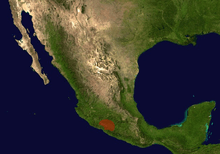Brachypelma auratum
Brachypelma auratum (also called Mexican flame knee) is a tarantula endemic to the regions of Guerrero and Michoacán in Mexico. In appearance it is reminiscent of the quintessential Mexican red-kneed spider, Brachypelma smithi, albeit darker and with more discrete red striations on the patella. The form of these red markings have earned the spider its common name, the flame knee. Due to the species' similarities to B. smithi, it was not considered a distinct species until 1992.[1][2] It has been found living communally with a small frog known as Eleutherodactylus occidentalis[3] [4][5]
| Brachypelma auratum | |
|---|---|
 | |
| Scientific classification | |
| Kingdom: | Animalia |
| Phylum: | Arthropoda |
| Subphylum: | Chelicerata |
| Class: | Arachnida |
| Order: | Araneae |
| Infraorder: | Mygalomorphae |
| Family: | Theraphosidae |
| Genus: | Brachypelma |
| Species: | B. auratum |
| Binomial name | |
| Brachypelma auratum Schmidt, 1992[1] | |
 | |
| Distribution of B. auratum | |
Conservation
In 1985, Brachypelma smithi (then not distinguished from B. hamorii) was placed on CITES Appendix II, and in 1994, all remaining Brachypelma species were added, thus restricting trade.[6] Nevertheless, large numbers of tarantulas caught in the wild continue to be smuggled out of Mexico, including species of Brachypelma.[7]
References
- "Taxon details Brachypelma auratum Schmidt, 1992". World Spider Catalog. Natural History Museum Bern. Retrieved 2017-09-29.
- Peter Klaas: Vogelspinnen: Herkunft, Pflege, Arten. Eugen Ulmer Verlag, Stuttgart 2003/2007, ISBN 978-3-8001-4660-4, s. 70
- http://www.keepingexoticpets.com/mexican-flame-knee-tarantula-brachypelma-auratum-care-sheet/
- https://www.academia.edu/15275346/The_Brachypelma_of_Mexico
- https://www.researchgate.net/publication/305399122_Brachypelma_of_Mexico
- "Brachypelma smithi (F. O. Pickard-Cambridge, 1897): Documents". Species+. UNEP-WCMC & CITES Secretariat. Retrieved 2017-09-22.
- Mendoza, J. & Francke, O. (2017). "Systematic revision of Brachypelma red-kneed tarantulas (Araneae: Theraphosidae), and the use of DNA barcodes to assist in the identification and conservation of CITES-listed species". Invertebrate Systematics. 31 (2): 157–179. doi:10.1071/IS16023.
External links
| Wikimedia Commons has media related to Brachypelma auratum. |
- Hijmensen, Eddy (2011), "Brachypelma auratum", mantid.nl, retrieved 2017-10-05 – photographs taken in the wild